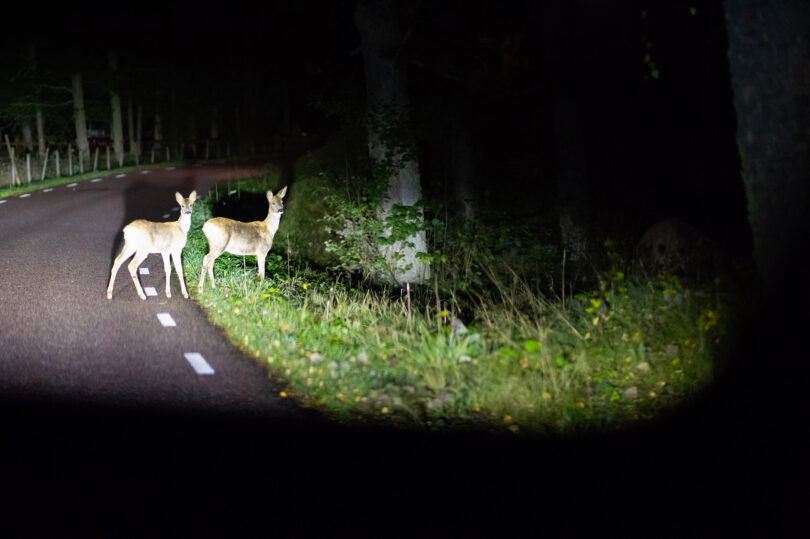According to a 2008 study, wildlife-vehicle collisions cost an estimated $8.4 billion in damages, with more than 58,000 people injured and 440 deaths occurring annually. These numbers continue to increase as urban sprawl expands and human-wildlife interactions increase. For many folks, wildlife-vehicle collisions are becoming a part of life. This is especially dangerous with days getting darker earlier.
A recent study conducted at the Savannah River Site by scientists and students from the University of Georgia’s Savannah River Ecology Laboratory sheds light on the ability of drivers to observe animals and avoid dangerous wildlife-vehicle collisions at night safely.
“Our goal was to examine how various animals, drivers and environmental variables influenced drivers’ ability to detect animals at night and avoid collisions. We wanted to better understand why wildlife-vehicle collisions at night are so common,” said Travis DeVault, associate director for research at the University of Georgia’s Savannah River Ecology Laboratory and senior author on this study.
“It’s the first study of its kind to use wild animals instead of decoys,” said Carson Pakula, SREL graduate student, lead author of the study, and co-advised by Travis DeVault and Olin “Gene” Rhodes. “This allows for a more realistic evaluation of a driver’s ability to discern wildlife. The implications from this study are significant because it demonstrates the importance of high-beam headlight usage, driving at safe speeds, and limiting the amount of time driving at night.”
To ensure consistency, the research team chose a single-vehicle model, gathered a group of 24 volunteers that reflected the demographic diversity of typical drivers, and selected a realistic driving route that replicated conditions that drivers encounter in the Southeast.
“In our study, we made some specific choices. We decided to go with a vehicle commonly seen on the roads in this region. So, naturally, we settled on the Ford F-150, as it has been the top-selling vehicle in the USA for the past 41 years. Additionally, we selected the Savannah River Site, spanning over 310 square miles, as our testing ground. It ticked all the boxes with its mostly level terrain, lots of wildlife such as deer and wild pigs, well-paved roads, and restricted access to the public. This was particularly crucial because it helped eliminate potential variables like increased road illumination from other drivers on the road during our experiments,” Pakula said.
The drives began 30 minutes after sunset, with the volunteers navigating a 47-mile circuitous route through the site in a truck equipped with an infrared video camera that could identify animals up to a half mile away. The camera provided a continuous live feed of all wildlife along the road to a researcher riding in the passenger seat. Besides watching it live, the video was recorded. Later, the footage was reviewed for actual animals encountered along the way. Drivers averaged between 45-55 mph.
Deer were difficult to see; pigs and other wildlife even harder to detect
Investigators found that approximately 45% of encounters with deer were dangerous. This means the detection distance was less than what was required to brake safely. The probability of an encounter with deer being dangerous increased when driving at higher speeds and as drivers became fatigued later in the drives.
“We were surprised by the decrease in detection distances for deer as drives progressed,” said DeVault.
Alarmingly, drivers failed 100% of the time to spot wild pigs with enough time to brake safely.
“Drivers generally spotted pigs at such short distances that if they had moved into the road, drivers might not have been able to brake in time to avoid collisions,” said DeVault.
He along with other researchers hypothesize that a driver’s inability to see wild pigs stemmed from their dark coloration, short stature and lack of eyeshine. Eyeshine happens when light bounces off a special layer (tapetum lucidum) in some animals’ eyes, making it reflective in low light.
Headlights played a dramatic role in recognizing wildlife. On average, deer were identified at 297 feet from the vehicle when drivers used high-beam headlights compared to 217 feet with low beams. To place this in perspective, 297 feet would be 20 cars lined up bumper to bumper and 217 feet would be 14 and half cars lined up (considering the average car length is 15 feet long). The 80-foot difference in detection distance is dramatic, at roughly 5 1/3 car lengths. Similar increases were seen when using high-beam headlights with coyotes, wild pigs and small mammals like raccoons.
“This distance is significant when folks are trying to avoid a collision with wildlife,” said Pakula. “The more time you have to react and make the necessary changes, the better.”
These statistics take on added significance as daylight diminishes and individuals drive more often after sunset.
How can you stay safe when driving at night?
While driving at night, there are several ways to decrease your likelihood of a collision with wildlife. First, reduce your speed. This increases your chances of braking safely if an animal crosses your path. Secondly, avoid long drives at night whenever possible. Drivers lose the ability to spot wildlife at safe distances as they become fatigued, as demonstrated by the study. Lastly, you are more likely to see wildlife when using high-beam headlights.
“Vehicle headlights are the primary means of illuminating potential roadside hazards to drivers at night. Drivers need good headlights to drive safely at night and should use their high beams whenever possible, especially given our findings showing how hard it is to spot deer, wild pigs and other wildlife along roads,” states DeVault.
The study, “Driving in the dark: Deciphering nighttime driver detection of free-ranging roadside wildlife,” was published in Transportation Researcher Part D by Pakula, Shane Guenin, Jonathan Skaggs, Olin E. Rhodes, Jr., and DeVault.








